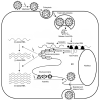Experimental therapies for yellow fever
- PMID: 23237991
- PMCID: PMC3563926
- DOI: 10.1016/j.antiviral.2012.12.002
Experimental therapies for yellow fever
Abstract
A number of viruses in the family Flaviviridae are the focus of efforts to develop effective antiviral therapies. Success has been achieved with inhibitors for the treatment of hepatitis C, and there is interest in clinical trials of drugs against dengue fever. Antiviral therapies have also been evaluated in patients with Japanese encephalitis and West Nile encephalitis. However, no treatment has been developed against the prototype flavivirus, yellow fever virus (YFV). Despite the availability of the live, attenuated 17D vaccine, thousands of cases of YF continue to occur each year in Africa and South America, with a significant mortality rate. In addition, a small number of vaccinees develop severe systemic infections with the 17D virus. This paper reviews current efforts to develop antiviral therapies, either directly targeting the virus or blocking detrimental host responses to infection.
Copyright © 2013 Elsevier B.V. All rights reserved.
Figures


Similar articles
-
A Chimeric Japanese Encephalitis Vaccine Protects against Lethal Yellow Fever Virus Infection without Inducing Neutralizing Antibodies.mBio. 2020 Apr 7;11(2):e02494-19. doi: 10.1128/mBio.02494-19. mBio. 2020. PMID: 32265332 Free PMC article.
-
Preclinical and clinical development of YFV 17D-based chimeric vaccines against dengue, West Nile and Japanese encephalitis viruses.Vaccine. 2010 Jan 8;28(3):632-49. doi: 10.1016/j.vaccine.2009.09.098. Epub 2009 Oct 4. Vaccine. 2010. PMID: 19808029 Review.
-
Comparative Infections of Zika, Dengue, and Yellow Fever Viruses in Human Cytotrophoblast-Derived Cells Suggest a Gating Role for the Cytotrophoblast in Zika Virus Placental Invasion.Microbiol Spectr. 2023 Jun 15;11(3):e0063023. doi: 10.1128/spectrum.00630-23. Epub 2023 May 25. Microbiol Spectr. 2023. PMID: 37227282 Free PMC article.
-
Development of a Bicistronic Yellow Fever Live Attenuated Vaccine with Reduced Neurovirulence and Viscerotropism.Microbiol Spectr. 2022 Oct 26;10(5):e0224622. doi: 10.1128/spectrum.02246-22. Epub 2022 Aug 18. Microbiol Spectr. 2022. PMID: 35980184 Free PMC article.
-
Live virus vaccines based on a yellow fever vaccine backbone: standardized template with key considerations for a risk/benefit assessment.Vaccine. 2015 Jan 1;33(1):62-72. doi: 10.1016/j.vaccine.2014.10.004. Epub 2014 Oct 27. Vaccine. 2015. PMID: 25446819 Free PMC article. Review.
Cited by
-
BCX4430, a novel nucleoside analog, effectively treats yellow fever in a Hamster model.Antimicrob Agents Chemother. 2014 Nov;58(11):6607-14. doi: 10.1128/AAC.03368-14. Epub 2014 Aug 25. Antimicrob Agents Chemother. 2014. PMID: 25155605 Free PMC article.
-
A Novel Benzodiazepine Compound Inhibits Yellow Fever Virus Infection by Specifically Targeting NS4B Protein.J Virol. 2016 Nov 14;90(23):10774-10788. doi: 10.1128/JVI.01253-16. Print 2016 Dec 1. J Virol. 2016. PMID: 27654301 Free PMC article.
-
Antivirals against Chikungunya Virus: Is the Solution in Nature?Viruses. 2020 Feb 29;12(3):272. doi: 10.3390/v12030272. Viruses. 2020. PMID: 32121393 Free PMC article. Review.
-
Yellow Fever: Integrating Current Knowledge with Technological Innovations to Identify Strategies for Controlling a Re-Emerging Virus.Viruses. 2019 Oct 17;11(10):960. doi: 10.3390/v11100960. Viruses. 2019. PMID: 31627415 Free PMC article. Review.
-
A humanized monoclonal antibody neutralizes yellow fever virus strain 17D-204 in vitro but does not protect a mouse model from disease.Antiviral Res. 2016 Jul;131:92-9. doi: 10.1016/j.antiviral.2016.04.013. Epub 2016 Apr 26. Antiviral Res. 2016. PMID: 27126613 Free PMC article.
References
-
- Barrett AD, Teuwen DE. Yellow fever vaccine - how does it work and why do rare cases of serious adverse events take place? Current opinion in immunology. 2009;21:308–313. - PubMed
Publication types
MeSH terms
Grants and funding
LinkOut - more resources
Full Text Sources
Other Literature Sources

